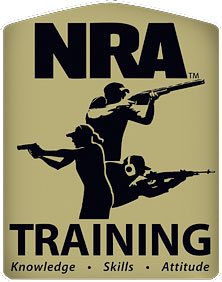Widgetized Section
Go to Admin » Appearance » Widgets » and move Gabfire Widget: Social into that MastheadOverlay zone
NRA Spotlights Safe Gun Use and Storage Practices for National Safety Month
The NRA highlights additional storage and handling rules for responsible gun ownership
 Fairfax, Virginia – Continuing our observance of June as National Safety Month (NSM), we are highlighting our rules for proper gun use and storage. Knowledge of safe gun handling techniques follows NSM’s stated goals of educating and influencing behaviors around leading causes of preventable injuries and deaths.
Fairfax, Virginia – Continuing our observance of June as National Safety Month (NSM), we are highlighting our rules for proper gun use and storage. Knowledge of safe gun handling techniques follows NSM’s stated goals of educating and influencing behaviors around leading causes of preventable injuries and deaths.
If you’re already familiar with our three fundamental Gun Safety Rules – ALWAYS keep the gun pointed in a safe direction; ALWAYS keep your finger off the trigger until ready to shoot; ALWAYS keep the gun unloaded until ready to use – these additional rules should be implemented as complementary practices.
“Displaying functional knowledge of a gun’s parts, proper maintenance techniques and taking measured precautions before shooting are essential skills for responsible gun owners,” said Bill Poole, Managing Director of NRA’s Education and Training Division. “Whether you own a firearm or not, knowing these rules will maximize safety and minimize risk of accident when one is present.”
When using or storing a gun, always follow these NRA rules:
- Know your target and what is beyond.
- Be absolutely sure you have identified your target beyond any doubt. Equally important, be aware of the area beyond your target. This means observing your prospective area of fire before you shoot. Never fire in a direction in which there are people or any other potential for mishap. Think first. Shoot second.
- Know how to use the gun safely.
Before handling a gun, learn how it operates. Know its basic parts, how to safely open and close the action and remove any ammunition from the gun or magazine. Remember, a gun’s mechanical safety device is never foolproof. Nothing can ever replace safe gun handling.
- Be sure the gun is safe to operate.
Just like other tools, guns need regular maintenance to remain operable. Regular cleaning and proper storage are a part of the gun’s general upkeep. If there is any question concerning a gun’s ability to function, a knowledgeable gunsmith should look at it.
- Use only the correct ammunition for your gun.
Only BBs, pellets, cartridges or shells designed for a particular gun can be fired safely in that gun. Most guns have the ammunition type stamped on the barrel. Ammunition can be identified by information printed on the box and sometimes stamped on the cartridge. Do not shoot the gun unless you know you have the proper ammunition.
- Wear eye and ear protection as appropriate.
Guns are loud and the noise can cause hearing damage. They can also emit debris and hot gas that could cause eye injury. For these reasons, shooting glasses and hearing protectors should be worn by shooters and spectators.
- Never use alcohol or over-the-counter, prescription or other drugs before or while shooting.
Alcohol, as well as any other substance likely to impair normal mental or physical bodily functions, must not be used before or while handling or shooting guns.
- Store guns so they are not accessible to unauthorized persons.
Many factors must be considered when deciding where and how to store guns. A person’s particular situation will be a major part of the consideration. Dozens of gun storage devices, as well as locking devices that attach directly to the gun, are available. However, mechanical locking devices, like the mechanical safeties built into guns, can fail and should not be used as a substitute for safe gun handling and the observance of all gun safety rules.
- Be aware that certain types of guns and many shooting activities require additional safety precautions.
- Cleaning
Regular cleaning is important in order for your gun to operate correctly and safely. Taking proper care of it will also maintain its value and extend its life. Your gun should be cleaned every time that it is used.
A gun brought out of prolonged storage should also be cleaned before shooting. Accumulated moisture and dirt, or solidified grease and oil, can prevent the gun from operating properly.
Before cleaning your gun, make absolutely sure that it is unloaded. The gun’s action should be open during the cleaning process. Also, be sure that no ammunition is present in the cleaning area.
NRAblog is your connection to the programs of the NRA. It is a project of the NRA’s Media Relations Division.
PUBLISHING:
NRA Executive Director: Kyle Weaver
CONTRIBUTORS:
Lars Dalseide. E-mail him at LDalseide (AT) nrahq.org.
Kyle Jillson. E-mail him at KJillson (AT) nrahq.org.
Justin McDaniel E-mail him at JMcDaniel (AT) nrahq.org.




 MidwayUSA
MidwayUSA Ruger Firearms
Ruger Firearms SCCY Firearms
SCCY Firearms Streamlight
Streamlight Action Targets
Action Targets Gunsite Academy
Gunsite Academy
You must be logged in to post a comment Login